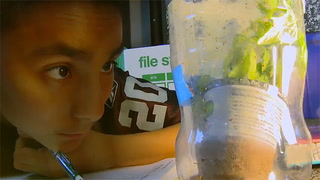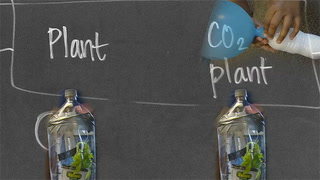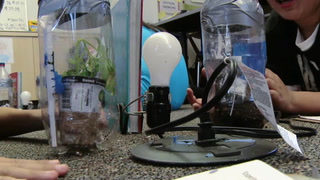Classroom Close Up: Climate Change in a Bottle - The Experiment
With Suney Park
[01:00:13;17]
Suney: "Alright. Scientists, scholars, and climate change researchers, are you ready?"
Students: "Yes."
Suney: Today in class, you were watching my sixth graders take what they've been learning about climate change, specifically the greenhouse effect, and with this experiment, make the greenhouse effect happen, in a model, like, right before their eyes.
"OK, When I say 'Go!', you're gonna turn the light on, and then that's when the first minute is gonna begin. Do your best. 5..4..3..2..1 Go!"
Climate change is an important concept to tackle, and I always want to try to incorporate a hands-on activity to make everything kind of come together. So, with this experiment, in our model, the light bulb is the sun. For the earth, we had the two-liter bottle, which they all brought from home. They are measuring increase in temperature in degrees Celsius.
Student: "My first reading is 21, Celsius."
Suney: So once the experiment started, the light bulb goes on, and then they start taking data.
"Take time, right now! Take it! That's minute one!"
Student: "All of us?"
Suney: "Yeah, everybody."
Student: "Ours is 26."
Student: "And you guys have control, right?"
Suney: "So each tick is what, two degrees. Right? So where do you see the red line at right now?"
Student: "26?"
Suney: "Yes, you see it at 26. So, put 26 down for, for one minute. Put it, one minute, and then put 26."
So, we were gonna measure the temperature for 15 minutes.
Student: "Mines is not changing. Mines is not changing at all."
Narrator: "And the time is?"
Student: "Not even a minute."
Suney: And right away, I know the students expected the temperature to soar, right? And, so they were getting discouraged. And one student even said "Oh, gosh, this is boring. It's not even doing anything."
"Minute! Take! This is Take 2! Two minutes!"
Student: "What is yours?"
Student: "It's still..."
Student: "Is it still 22?"
Student: "It's still 22."
Suney: I definitely want them to know the scientific process is one that's painstaking; that they do need to be patient.
Student: "Ding, ding, ding, ding, ding"
Suney: "Take three!"
Student: "I got 25."
Student: "26!"
Suney: Seeing their impatience with that, that's also a, a nice teaching opportunity because um, change is very gradual.
Student: "Oh yeah! Mine is going up a little!!"
Student: "Yeah, mine went up a half."
Student: "Yeah, me too!"
Suney: Especially as scientists, even the tiniest jump could make such a big difference, and has significant meaning, and I want them to be able to see that.
"Hey guys, do you know, did any of you read in the book where it says that just changing one degree Celsius can turn a popsicle..."
Student: "Yeah."
Suney: "And, what did it say?"
Student: "It said...didn't it say it could change a popsicle to...didn't it just say water? It says...yeah, it was water."
Suney: "To melt it."
Student: "Yeah."
Suney: "So one degree Celsius, like you guys are saying "Oh, it's barely doing anything", but if we're talking about like in the earth and the climate, one degree can change a popsicle..."
Student: "It could melt the ice...icebergs."
Suney: "Icebergs! Like the glaciers!"
Student: "Yeah"
Suney: "Remember Glacier National Park is gonna be Glacier National Park no more?"
We try to make it meaningful, something that they can go home, and have a conversation about; turn on the news and be able to say "Oh my gosh, I'm doing that in class." It just makes it more fun and exciting, and fulfilling to them.
Student: "'Cause the CO2, like in real life, it's making us warmer, so in the bottle, it's making that plant warmer..."
Student: "Greenhouse gas."
Suney: When I see my students make connections between what they're learning and what's going on in the world, it is so powerful and it's so amazing, and it makes you feel like what you're doing is making a difference.
"And maybe, just maybe your lab report will gain the attention of the world....of the world."














8 Comments
Kristi Nichols Nov 28, 2017 1:31pm
Sherry Thomas Sep 17, 2017 5:02pm
Carlos Cotman Mar 7, 2017 10:57am
Lynne Gayler Nov 14, 2016 7:38pm
Amanda Amburgey Mar 13, 2016 4:07pm